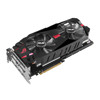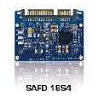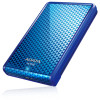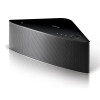
A year ago the market has acquired not a revolutionary GPU but a simple descendant of the GeForce256, it had an increased frequency due to a more advanced technology, and two texture modules per each of 4 rendering pipelines. And that's all. The Hardware TCL of the GeForce2 GTS was also an overclocked version of the previous geometrical coprocessor of the GeForce256. Undoubtedly, there were some improvements (particularly, in 2D graphics), but nothing revolutionary appeared.
Certainly, a 0.18 micron chip can't admit both high speed capabilities and considerable improvements in the support of many modern functions of 3D-graphics. A year ago the GeForce GTS showed that a video memory bandwidth was a severe bottleneck for the overall system performance. Video cards that cost 1.5 times more than the previous generation (the GeForce256 DDR) were equipped with the same 166-MHz DDR-memory, which cut the potential of the GeForce2 GTS by half. 32-bit color suffered...
So, there arises a question about a serious rework of the technology, since an increase of frequencies and the number of pipelines wasn't effective (the memory bandwidth was still low). There is quite a big number of recipes for improvement, for instance, the tile architecture or hierarchical Z-buffer.
A year after the release of the GeForce2 GTS, NVIDIA introduced the GeForce3. At the end of the winter the cards based on it were too expensive. Of course, it is a High-End solution and it is not intended for all users. Video card manufacturers are in a difficult situation. Users are longing for the time when a new accelerator didn't exceed $250. But NVIDIA can dictate its terms since there are no any other large-scale videoprocessor manufacturers.
However, not so long ago we witnessed the appearance of the KYRO II released by STMicroelectronics which took away Hercules/Guillemot from NVIDIA. It gave a splash to the competition in this market.
This fact, as well as the delay in release of the GeForce3 caused the decrease in prices for the still unlaunched GeForce3 based video cards. If in winter they were said to be $550-600, now the upper limit is $399. It means that the real price will be $360-380, which is near to the last year's price of the GeForce2 GTS cards with 32 MBytes memory. It is a good sign since the GeForce2 Ultra cards were much more expensive than today's GeForce3 ones.
So, we are ready to consider a new video card based on this powerful GPU. The processor itself was already considered in some of our articles:
- GPU NVIDIA GeForce3 and Cards on It
- Optimization of NVIDIA GeForce3 for Intel Pentium4 and AMD Athlon
- MadOnion 3DMark2001 and NVIDIA GeForce3 - The Love Story
- NVIDIA GeForce3 Benchmarking with Vulpine GLMark
In this review I'm going to omit all the theoretical issues concerning the GeForce3, and focus our attention on a new production sample from ASUSTeK - the ASUS AGP-V8200 Deluxe card.
Card
The ASUS AGP-V8200 Deluxe has an AGP x2/x4 interface, 64 MBytes DDR SDRAM located in 8 chips on the face side of the PCB.
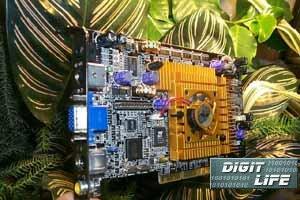
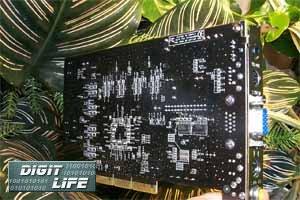
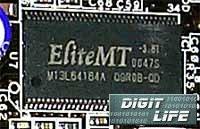
EliteMT's memory chips with a 3.8 ns access time which corresponds to 260 (520) MHz are present here. The memory works at 230 (460) MHz. We have already seen this frequency on the GeForce2 Ultra cards but the chip had a 4 ns access time. Even the installation of a faster memory didn't help the developers to overcome the fear of overheating.
The card's design is completely developed by ASUSTeK's engineers.
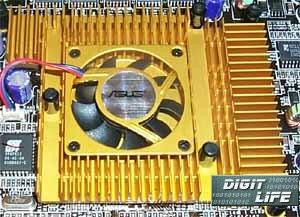
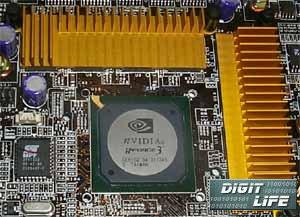
A massive cooling system of golden color arrests our attention. ASUSTeK has applied a completely new unusual construction consisting of a central heatsink with a fan and adjoining side fin heatsinks.
In the new design the memory modules are located nearer to the graphics processor that is why it seems that the larger heatsink is joined with the heatsinks cooling the memory chips (in the upper right photo).
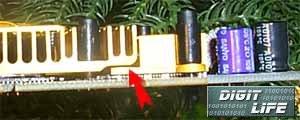
But in reality the central and side heatsinks do not touch each other (in the right photo a red arrow shows a slit between the heatsinks), that is why the fan cools only the central heatsink. For the sake of such a stylish design the upper heatsink has lost quite a big number of fins and therefore it is not so effective as, for example, the element located on the right and cooling the vertical row of chips.
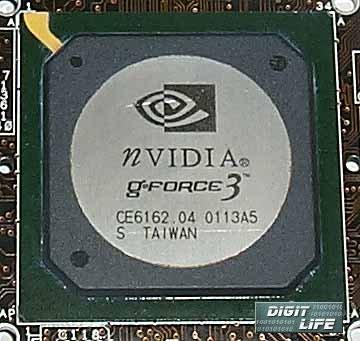
Besides, the GPU is marked 'GeForce3', and not 'NV20', as we could see on the pre-production samples. The marking says that the processor has a A05 stepping and it was released at the end of March. Despite the 0.15 micron process, the chipset contains more than 50 million of transistors that is why the heating is not moderate. As you can see, it has a metallic lid on the plastic case which allows a better cooling of the chip.
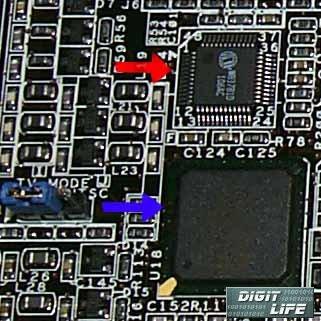
On the lower left of the PCB there is a thermo-control chip (marked with a red arrow), and the Philips 7100 module intended for VIVO control (Video Input, Video Output) - it is marked with a blue arrow.
It is the first time ASUSTeK has started to use one processor for conversion of a video signal from digital into analog and back on Deluxe (or TVR) video cards. Previously they installed different chips for TV-out and TV-in.
In the same photo you can see a jumper meant to be used for choosing a TV-out signal format (NTSC/PAL). It also can be done in the settings of drivers.
The card is equipped with a status monitoring technology - SmartDoctor (there is a thermo-control chip, and the cooler has a tachometer). This technology was described in our reviews of ASUSTeK's video cards, for example the ASUS AGP-V6800. I should only add that SmartDoctor is useful only for monitoring the current temperature, voltage and cooler rotation frequency. And I don't recommend to use it all the time since the software part will constantly decrease frequencies which may affect 2D graphics.
I have already mentioned that ASUSTeK had turned to dark colors of their cards, and this card is dark brown, like coffee.
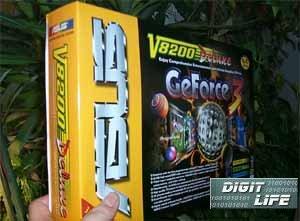
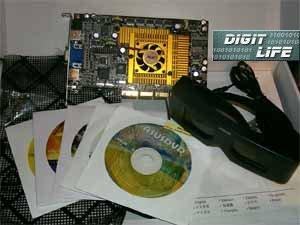
The card is delivered in a Retail-package of a traditionally (for Deluxe-series) large size. The box contains:
- User's Manual;
- A CD with drivers and utilities;
- ASUS DVD 2000 - soft DVD-player;
- Ulead Video Studio v.4.0 SE;
- CyberLink VideoLive Mail 4;
- 3Deep v.3.2;
- S-Video and RCA extenders;
- Adapter for Video In: S-Video-to-RCA;
- Stereo glasses.

Here you can see the languages represented in the User's Manual

The complete set includes stereo glasses traditional for Deluxe-series. There are bookmarks in ASUSTeK's drivers for activation of a stereo mode and adjusting it for your eyes. Your monitor must support the frame refresh rate not lower than 140 Hz at 800X600 and higher resolutions. But the support of 150 Hz is better since frames will be displayed at the double frequency (image interleaving for the left and right eyes with 70-75 Hz frequencies). All other settings depend on your preferences. The settings contain presets for popular games.
A TV-out has two connectors (S-Video and RCA), that is why you need no adapters if your equipment hasn't got a S-Video.
Overclocking
The ASUS AGP-V8200 Deluxe has reached 240/270 (540) MHz. It is an absolute record among the GeForce3 cards that we have studied before! Of course, a new revision and the usage of memory heatsinks have contributed to such a success.
Installation and Drivers
The test system configuration:
- The Pentium III based system:
- CPU - the Intel Pentium III 1000 MHz:
- The ASUS CUSL2-C Black Pearl (i815EP) mainboard;
- RAM - 256 MBytes PC133;
- HDD - the IBM DPTA 20 GBytes;
- OS - Windows 98 SE;
- The Athlon based system:
- CPU - the AMD Athlon 1200 (133 MHz x 9):
- The Soltek 75KAV-X (VIA KT133A) mainboard;
- RAM - 256 MBytes PC133;
- HDD - the Fujitsu 10 GBytes;
- OS - Windows 98 SE;
The ViewSonic P810 (21") and ViewSonic P817 (21") monitors.
For our tests we used NVIDIA drivers version 12.00. VSync was off.
For comparison we used the results of the following video cards:
- SIGMA Cyber5500 (GeForce2 MX),
- SIGMA Cyber6000 (GeForce2 GTS),
- Hercules 3D Prophet II Pro (GeForce2 Pro),
- Leadtek WinFast GeForce2 Ultra,
- ATI RADEON 64 MBytes DDR (183MHz).
As a reference card based on the NVIDIA GeForce3 we used the Leadtek WinFast GeForce3 (A03 revision).
ASUSTeK's drivers version 12.00-beta supplied with the card are quite raw and hangup (when entering the settings) quite often, that is why we didn't use them. Nevertheless, the stereo-mode settings work perfectly.
There are a lot of tweaking programs for the fine adjustment of NVIDIA's drivers. I prefer the Riva Tuner utility (by Aleksei Nikolaychuk AKA Unwinder unwinder@medicom-mtd.com). The last version is already adapted for Detonator version 12.00.

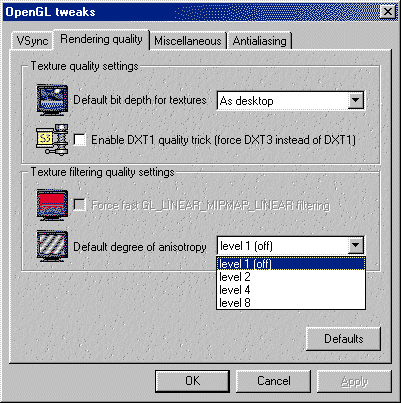
With Riva Tuner you can correctly enable the anisotropic filtering not only in OpenGL but also in Direct3D. We have already written about three degrees of anisotropy in the GeForce3: 8, 16 and 32 texture samples. The last degree is the most beautiful but also the heaviest as far as the performance is concerned. You can read about it in our review on the GeForce3.
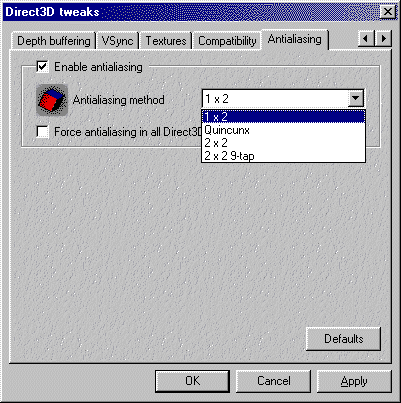
Riva Tuner allows anti-aliasing not only with NVIDIA's documented list of degrees but also the highest MSAA degree (absent in the driver settings) - 2x2tap9, which uses sampling not from 4 subpixels (2X2), but from 9 (3X3), however the rendering resolution increases not by 9 times, but by 4. The anti-aliasing quality gets, therefore, better than in case of a simple 2X2 degree. Look at the panel of NVIDIA driver settings:
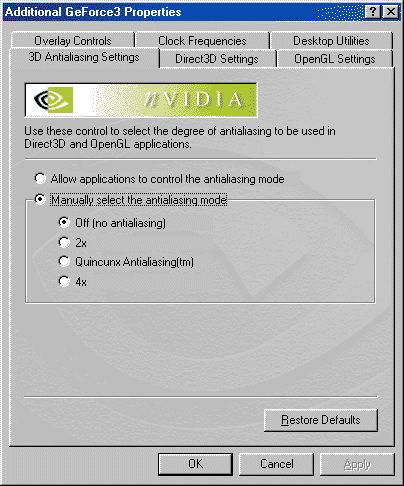
Riva Tuner allows to overclock video cards correctly, without rebooting after the first overclocking:
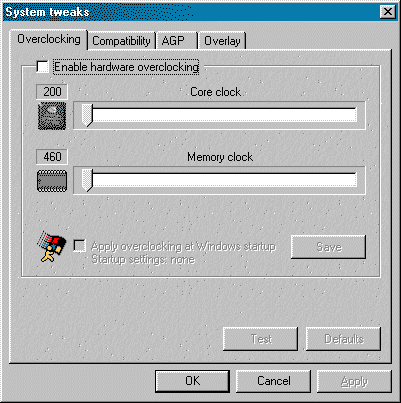
Test Results
The ASUS AGP-V8200 Deluxe shows a perfect quality level in 2D despite a heap of additional functions (VIVO) which usually worsens the image quality. The quality of layout of the card and components of output circuits is very high.
Now as for the 3D performance. Here we used the following programs:
- id Software Quake3 v.1.17 is a game-test which demonstrates the card's operation in OpenGL with the usage of a standard demo-benchmark demo002 and 'quaver' using q3dm9 level with large textures;
- PlanetMoon Giants v.1.396 (gamegauge) is a game-test that shows the card's operation in Direct3D in a multitexturing mode with the usage of very complex scenes;
- Massive Development AquaNox (AquaMark v.2.2) is a game test showing the performance in Direct3D using pixel shaders in very complex scenes (up to 170,000 polygons).
Quake3 Arena
demo002
The tests were carried out in two modes: Fast (shows the card's work at 16-bit color) and High Quality (shows the card's work at 32-bit color).


The test shows the position of the flagship of 3D game graphics in NVIDIA's chipset series. At 16-bit color the GeForce3 is behind its predecessor - the GeForce2 Ultra, but at 32-bit color it is an absolute leader. The ASUS AGP-V8200 Deluxe shows the performance at the level of the cards based on this chipset we have considered before.
demo002, the highest quality
The testing was carried out at 16- and 32-bit color with the highest possible settings.
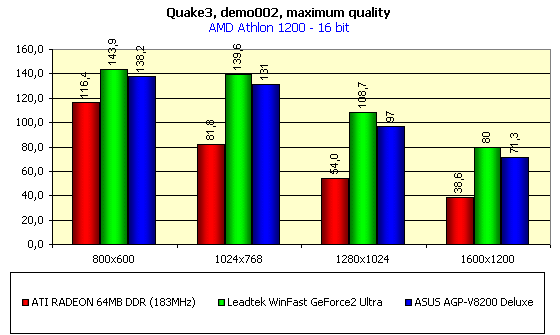
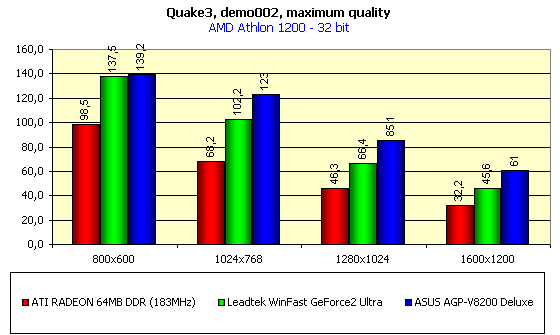
The situation is the same in more severe conditions.
quaver, the highest quality
The testing was carried out at 16- and 32-bit color at the highest possible settings.
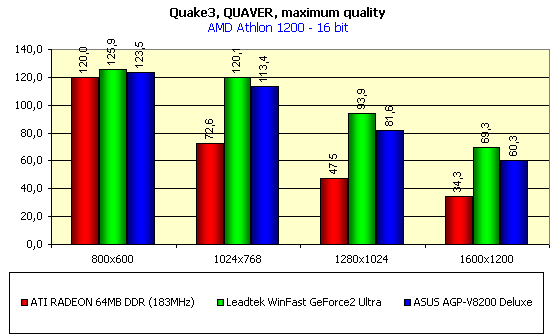
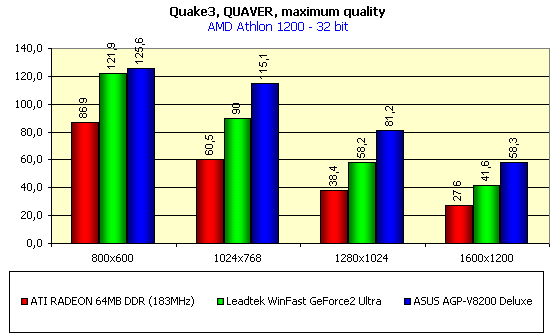
When using the Q3dm9 level, where a very large texture array is used with the highest quality the situation differs only in a wider gap between the GeForce3 and the GeForce2 Ultra at 32 bit color.
Scalability, i.e. The Dependence of The Performance On The CPU Frequency
The tests were carried out in two modes: Fast (shows the card's work at 16-bit color) and High Quality (shows the card's work at 32-bit color).
In these tests we used 2 processors: the Intel Pentium III-1000 (with the rated frequency and a decreased one - to 750 MHz), the AMD Athlon 1200 (133 x 9).
Let's consider the situation with respect to resolutions:
- 800x600 - here everything depends on the processor. At 16-bit color on the weak processor the GeForce3 card (purple columns) has fallen not only behind its predecessor (blue columns), but also behind a much weaker card on the GeForce2 GTS (green columns). And only the ATI RADEON 64 MBytes DDR (red columns) is left behind. And at 32-bit color the GeForce3 is beaten by the GeForce2 Ultra only on the Pentium III-750.
- 1024X768 - at 16-bit color the performance of all cards (except the ATI RADEON) depends on the processor frequency, and at 32-bit color the ATI RADEON 64 MBytes DDR and GeForce2 GTS depend also on their own power. That is why at 16-bit color the situation is similar to the previous one where the GF3 has lagged behind the GeForce2 Ultra. At 32-bit color it loses only on the weakest processor - the Pentium III - 750 MHz. On the more powerful processor the GeForce3 gains revenge.
- 1280X1024 - the situation changes in favor of the GeForce3. Only at 16-bit color it falls behind the GeForce2 Ultra, and at 32-bit color it goes far ahead even on the weakest processor, though you can see that the low frequency of the CPU doesn't allow a large gap. All other cards don't depend on the processor already.
- 1600X1200 - at 16-bit color the GeForce3 is almost at the same level with the GeForce2 Ultra, and all other cards are limited by their own capabilities. At 32-bit color the GeForce3 is an undoubted king. But here even the ASUS AGP-V8200 Deluxe has exhausted its potential, and the performance doesn't go up with the increase in CPU frequency.
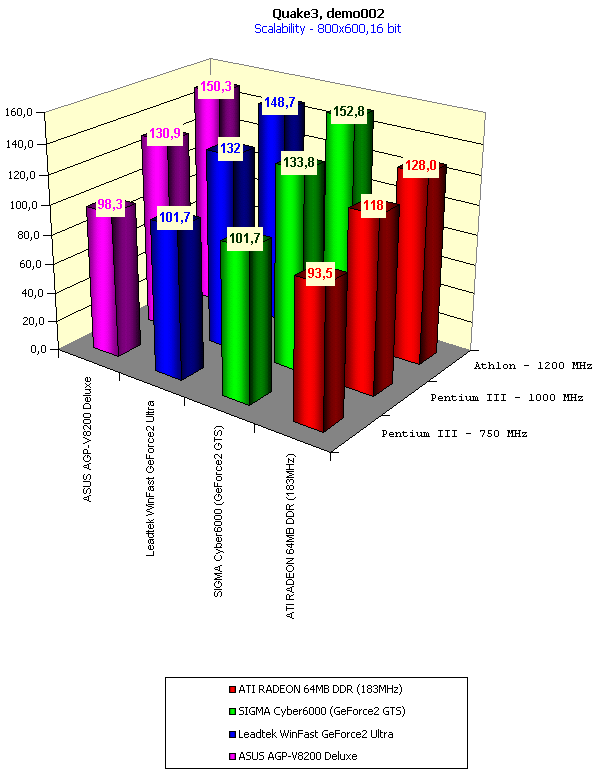
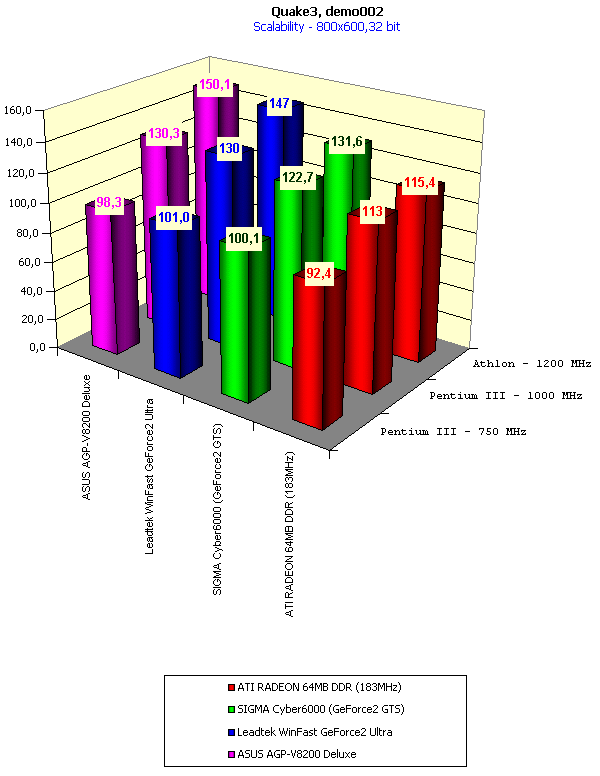

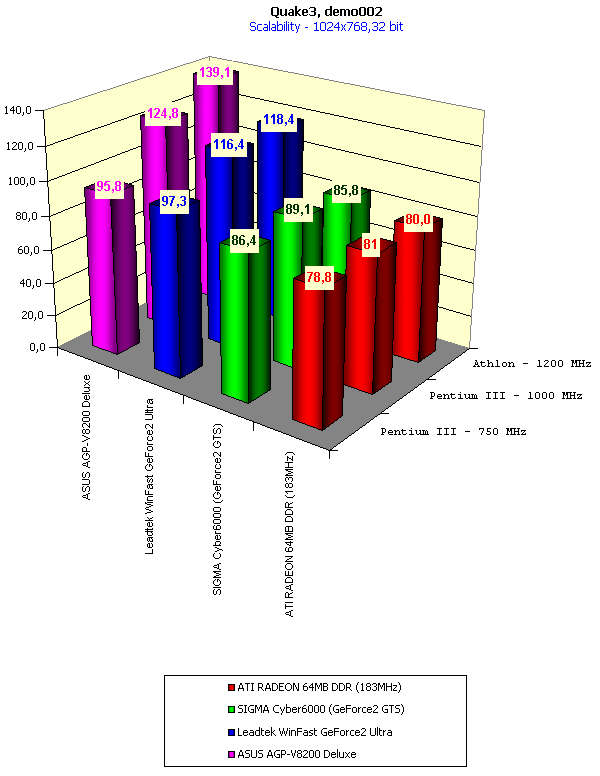
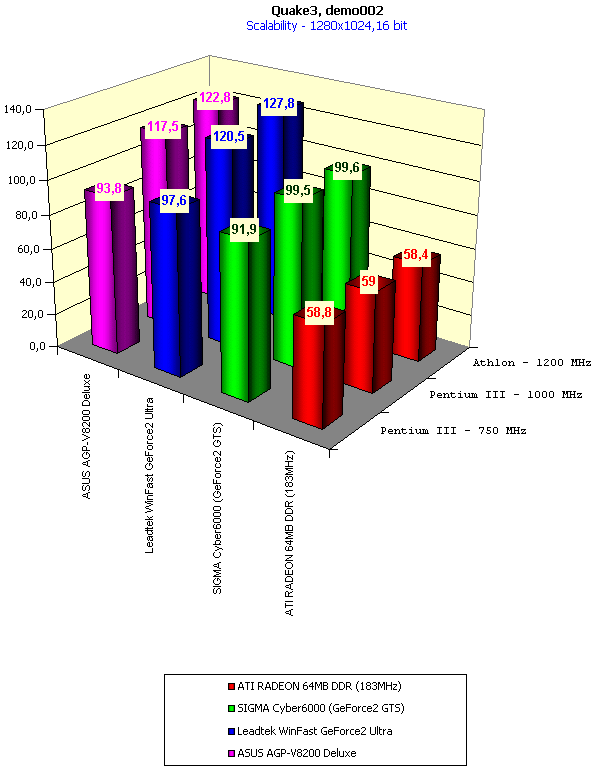
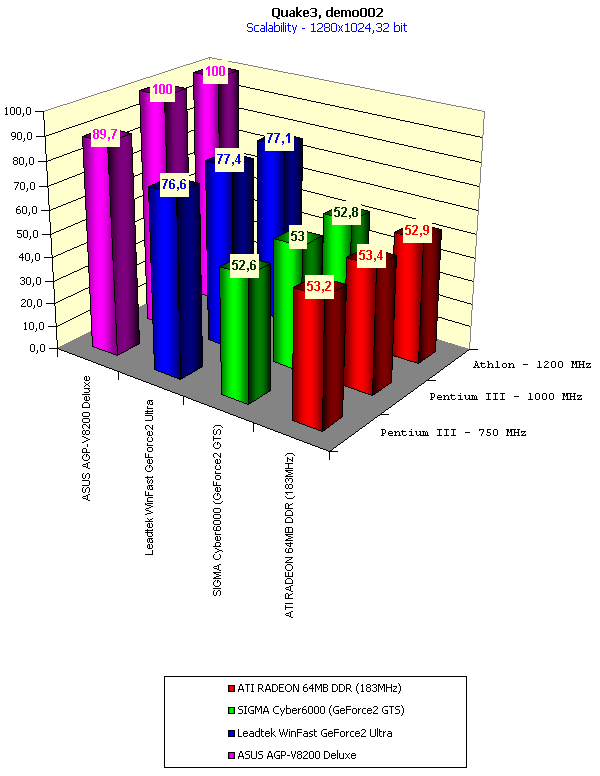
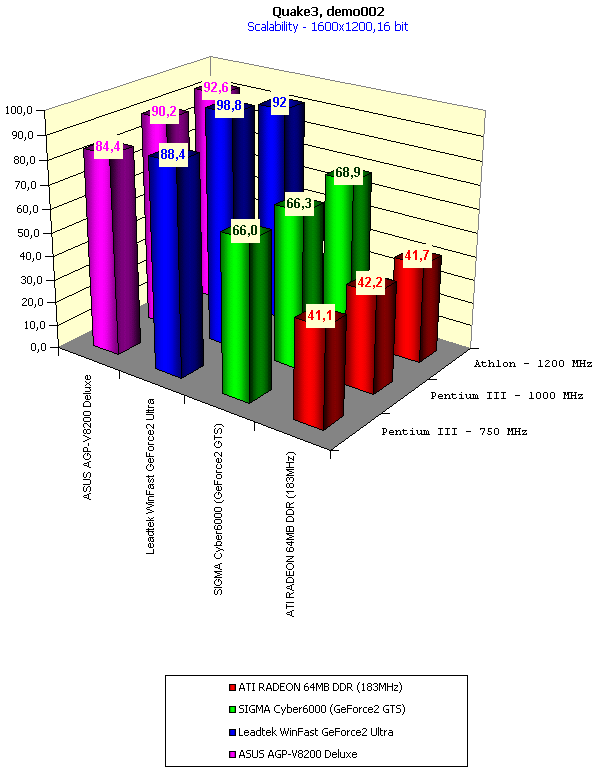
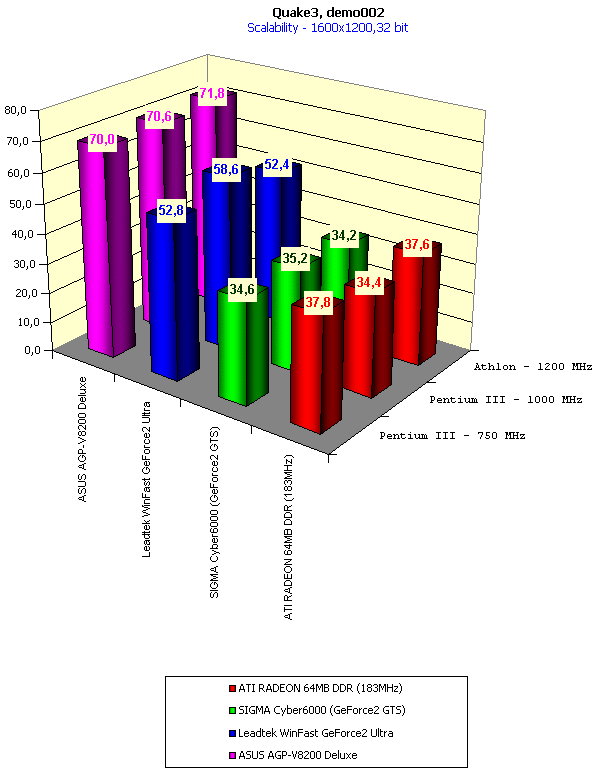
You can see that it is worth buying a card of the ASUS AGP-V8200 Deluxe class only for owners of high-frequency processors (from 1 GHz). Even 750 MHz cut the video card potential tremendously making it beneficial only at high resolutions.
Anti-aliasing
The tests were carried out in two modes: Fast (shows the card's work at 16-bit color) and High Quality (shows the card's work at 32-bit color).
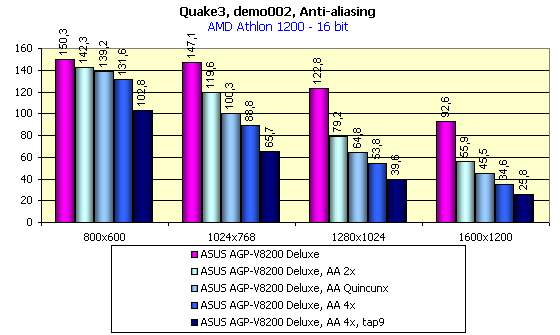

In this part we are going to consider the performance decrease with anti-aliasing enabled. I have studied all AA types (thanks to Riva Tuner for 2X2-tap9). In the first article on the GeForce3 these capabilities were already considered. I would only add that NVIDIA has realized a skillful MSAA method - Quincunx, when the resolution is increased 4 times, like with the usual 2X2 AA, but the subpixel sampling is carried out in an unusual way: there is not only a 2X2 square used, but also neighbor subpixels, so that we have got a sampling of 5 subpixels (criss-cross). For the realization of an output pixel there is a 3X3 square, however, not all 9, but only 5 subpixels are used (in the first review there are some explanatory schemes). That is why we get the quality similar to the AA 3X3, but with much lower expenses. The AA 2X2-tap9 is the same Quincunx, but with all 9 subpixels taken into account, and the speed decrease is more notable. You can look at the AA quality in the review on the NVIDIA GeForce3.
As one can see, 800x600 allows a good playability with all AA types. At 1024X768 one can play comfortably at 32-bit color with AA Quincunx (the higher AA degree is unnecessary since the quality obtained with the Quincunx is very high). In some games even at 1280X1024 the AA allows a decent playability.
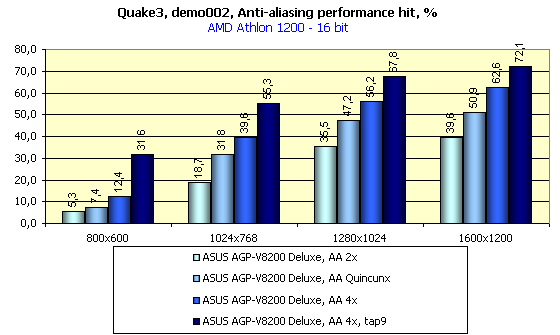
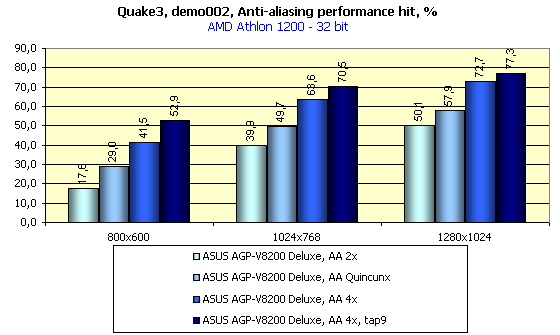
In conclusion, I'd like to show you some figures of the performance decrease when different AA degrees are enabled.
Overclocking
The tests were carried out in two modes: Fast (shows the card's work at 16-bit color) and High Quality (shows the card's work at 32-bit color). We have used two resolutions: 1280X1024 and 1600X1200, since at lower ones the overclocking doesn't work upon the performance due to the influence of the CPU frequency.
1280X1024
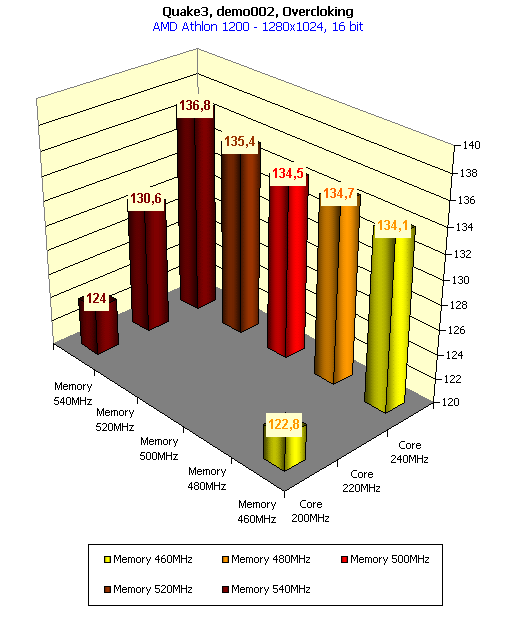
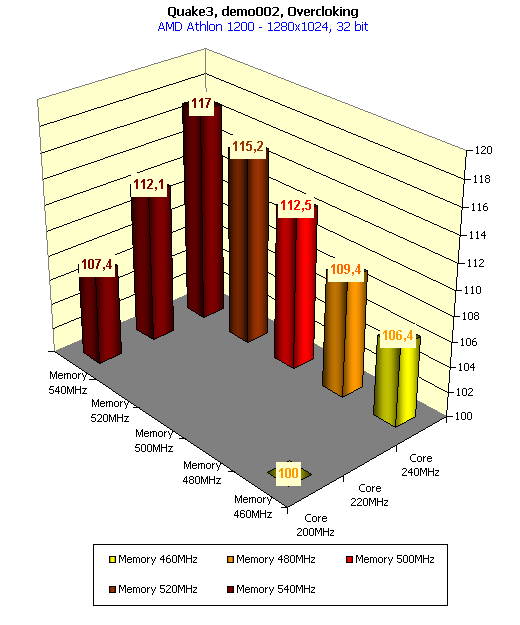
At 16-bit color everything depends only on the GPU frequency, the memory frequency makes no effect here, since the memory bandwidth is quite wide.
At 32-bit color the performance depends on the GPU frequency and memory speed equally. It proves the fact that the GeForce3 cards are more balanced solutions than the GeForce256/GeForce2 ones.
1600X1200
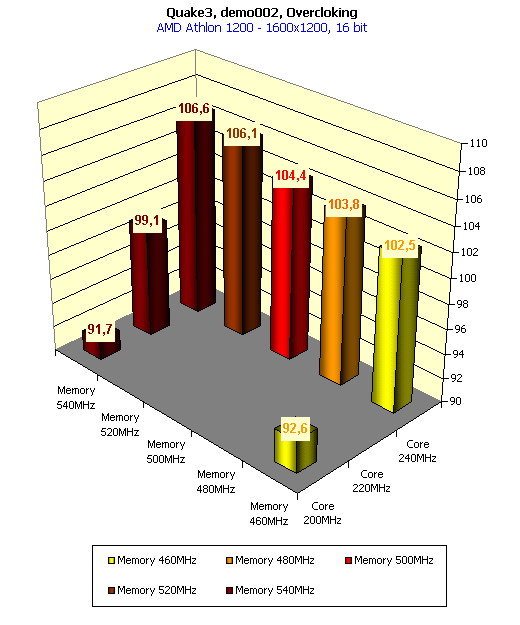
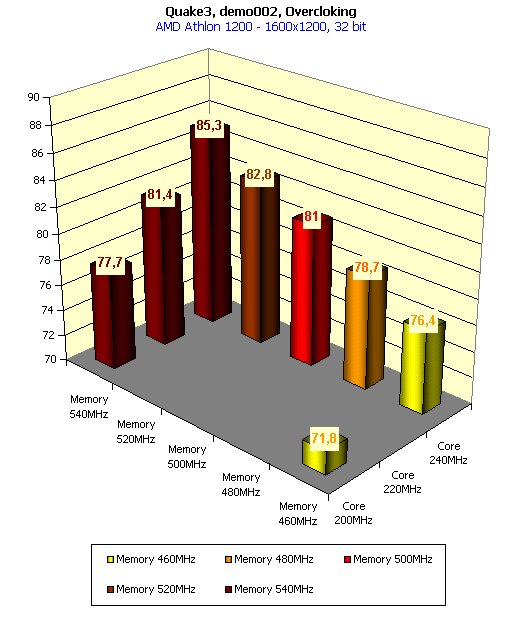
The situation is very similar to the above-mentioned, at 16-bit color an increase in the memory frequency becomes slightly important due to the growth of the GPU's requirements to the memory at such a huge resolution. At 32-bit color both the GPU and memory frequencies influence the performance equally.
So, as for NVIDIA's chipset of the previous generation we overclocked first of all the memory, when using the GeForce3 cards one should overclock both the GPU, and the memory.
We conducted all our overclocking processes with an additional cooling provided (the card was equipped with an additional fan). I don't recommend to overclock the card without any extra cooling.
Also note that overclocking results depend on the definite sample, the results of which don't form a definite rule for the trademark or series.
Giants
This game is used to show the card's speed in Direct3D. All settings are set to maximum that is why the test is very tough for many video cards. Hardware T&L is enabled.
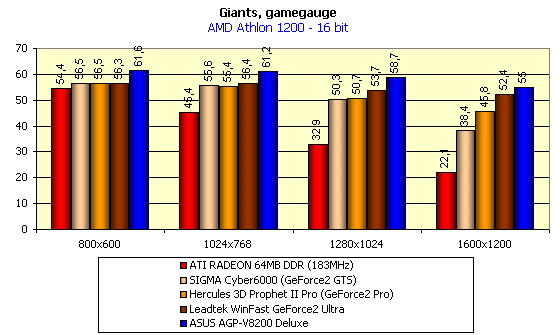
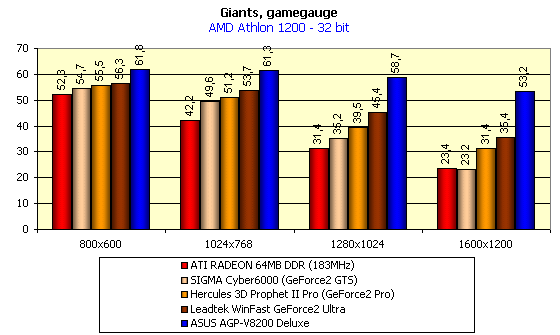
At low resolutions the CPU frequency matters most of all, but note that at 16-bit color the GeForce3 doesn't fall behind the GeForce2 Ultra. The heavy load has a great effect here, and even a higher frequency of the GeForce2 Ultra doesn't help the card on this GPU not to fall lower than the ASUS AGP-V8200 Deluxe. At 32-bit color the latter has enlarged the gap. The overall performance is not very high, a great deal of effects of complex scenes have resulted in the fact that even the ASUS AGP-V8200 Deluxe couldn't give more than 61 fps at 32-bit color. However, in games like Giants it doesn't matter much since they do not need hundreds of FPS.
AquaNox
This game was announced at the same time with the GPU GeForce3 and it will completely support DirectX 8.0 as far as the usage of shaders is concerned. Today there is only a demo-version. But it has served a base for an AquaMark benchmark.
This benchmark will help us estimate the card's speed in Direct3D both with the usage of pixel shaders and without them. The settings in the game allow only one option - changing the texture array size, I've used the default value - 24 MBytes. Note that this test is more stressful than Giants, since apart from a great variety of effects it uses scenes of colossal complexity, around 170,000 polygons! Of course, Hardware T&L is used actively.
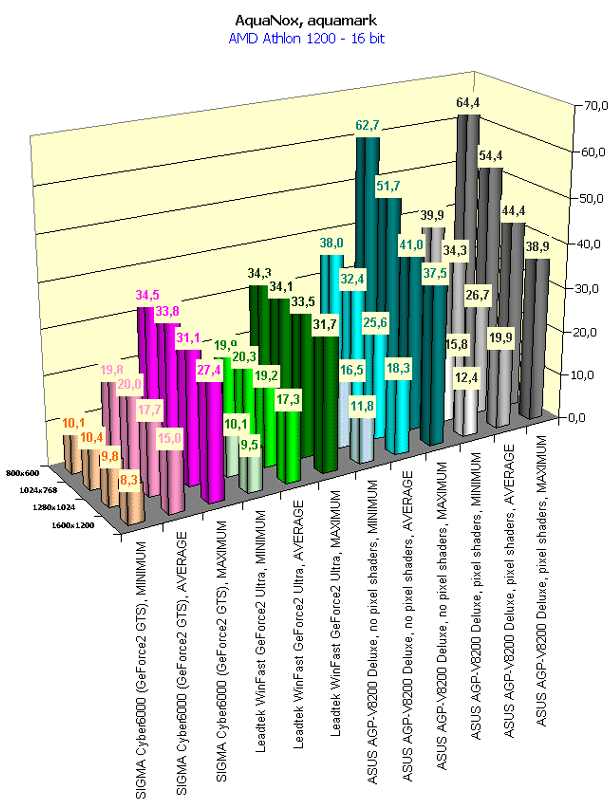
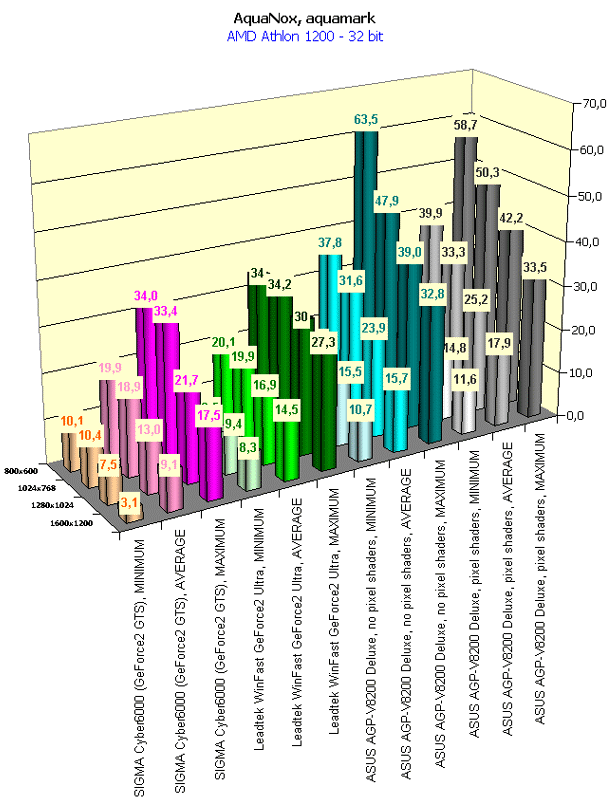
Here even the ASUS AGP-V8200 Deluxe has shown very poor playability! Unfortunately, the ATI RADEON didn't work on this benchmark (though it is not fair to say that AquaMark was designed exactly for NVIDIA-based cards since many other cards, e.g. Matrox G400, work with it flawlessly). And like in Giants, heavy situation with complex scenes makes the ASUS AGP-V8200 Deluxe a leader at 16-bit color.
Certainly, the developers will include the necessary number of options in the ready game to lighten loads on accelerators. The engine of the game will possibly be optimized. Below you can see some screenshots of this test:




3D Quality Issues
We have already concerned the problem of 3D quality of the GeForce3 video cards in our first review and in 3Digest (there are two galleries of screenshots). I recommend to read these articles, as well as a part in 3Digest concerning anisotropic filtering.
The Demo-CD supplied with the GeForce3 based video cards will include a new demo version of a forthcoming game - X-Isle: Dinosaur Island. This program combines a unique beauty of the graphics and rich effects. This adventure game with 3D-Action elements will appear by Christmas. Here you can see some screenshots of this demo obtained on the ASUS AGP-V8200 Deluxe.






Additional Functions: VIVO (Video In, Video Out), DVD
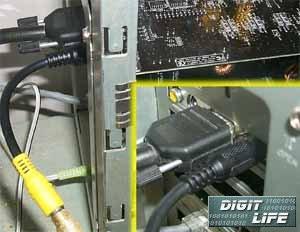
The complete set includes an S-Video-to-RCA adapter so that owners of video equipment lacking for an S-Video connector can connect an output from a VCR or video camera to Video In on the ASUS AGP-V8200 Deluxe.
Unfortunately, I can't tell you about all multimedia functions of this card due to the raw software. I promise I will consider them (VIVO) as soon as production samples of the ASUS AGP-V8200 Deluxe appear on the shelves.
It should be noted that ASUS DVD 2000 (a DVD-player) doesn't know the GeForce3 and it has refused to activate the hardware support of DVD. The previous WinDVD 2.1 could do it without any problems. The CPU utilization hasn't exceeded 22-24%.
Conclusion
The first production sample of the NVIDIA GeForce3 based card - the ASUS AGP-V8200 Deluxe - makes a strong impression. It is really a High-End solution.
The GeForce3 is a revolutionary spurt as far as new technologies and perfection of old ones are concerned. Video cards of this class can realize nearly all known 3D effects. That is why for gamers longing for perfect speed at 32-bit color and a heap of effects a purchase of such cards as the ASUS AGP-V8200 Deluxe will give the highest performance at Truecolor. But one has to wait a bit, as far as shaders are concerned, since most games "for DirectX 8.0" are still being developed. They won't appear at least until autumn.
Of course in autumn a new chip will be introduced to users, but it will be only an overclocked GeForce3, and we don't know how high the price for such cards will be, and cards like the ASUS AGP-V8200 Deluxe will have their prices cut pretty well. A revolutionary new product from NVIDIA will be released only in a year.
Certainly, there are not many people with purses thick enough to admit such cards, however, the reduction of prices is a regular occurrence. But before you purchase such a powerful accelerator you should make sure that your system is equipped with a powerful CPU. It is clear that it makes no sense to install such video cards on a system with a processor weaker than 1 GHz, since it can cut the video card potential tremendously even at the popular resolution - 1024X768.
As for the ASUS AGP-V8200 Deluxe, I want to draw your attention to the perfect implementation of the product and its original design once again. Plus, it is the trademark of ASUS which has never made any bad stuff (except incidents like the 16 MBytes GeForce2 MX :-).
In our 3Digest you can find the full comparison of characteristics of cards of this and other classes.
Highs:
- Perfect performance in 3D graphics, especially at 32-bit color;
- Excellent implementation quality;
- Marvelous overclockability;
- Stylish and unique design;
- Hardware Monitoring in the form of the SmartDoctor technology;
- Combination of 3D power with multimedia functions support and stereo glasses.
Lows:
- Too pricey.
Write a comment below. No registration needed!







